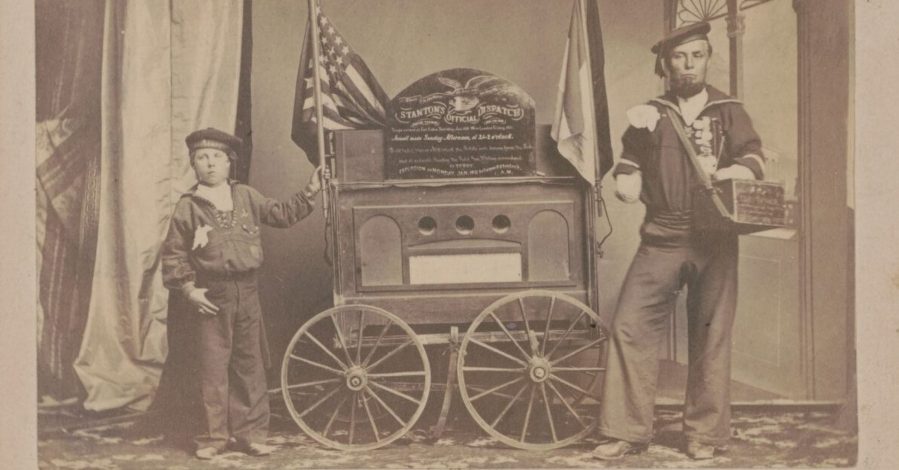Volume 45, No. 1, March 2019
The March issue contains articles by Ronald J. Zboray and Mary Saracino Zboray, Christopher W. Shaw, Scott D. Peterson, Sofiene Malloui and Michael S. Sweeney, and Allan Boughey, as well as an essay by Allie White on an archival collection of interest to mass communication historians. Interested in reading these articles? Get information on subscribing here.
Article Abstracts
“Recovering Disabled Veterans in Civil War Newspapers: Creating Heroic Disability,” Ronald J. Zboray and Mary Saracino Zboray (Research Essay)
This article recovers the largely untold story of newspaper coverage of disabled veterans during the American Civil War, through the case of Massachusetts sergeant Thomas Plunkett, who lost both arms in December 1862 at Fredericksburg, Virginia. News clips about him, along with comparative evidence of earlier coverage of people called “armless” or having “lost both arms,” are drawn from 528 relevant articles appearing in the United States between 1830 and 1865, with supplementary information regarding the postbellum years. We argue that Northern newspaper editors’ desire to make Plunkett a symbol of the Union cause led them to create the persona of the Armless Hero, a then-singular construction in the divided nation. In so doing, they forged a new discourse of heroic disability scarcely seen in prior coverage. That new discourse, through its eventual application to similarly disabled veterans, altered newspapers’ representations of disability in the war’s remaining years and afterward.
“The Story Was Not Printed: The Press Covers the 1930s Banking Crisis,” Christopher W. Shaw
The numerous bank failures that were a defining feature of the Great Depression received minimal news coverage. During the early 1930s, the media consistently downplayed the problems that pervaded the nation’s banks and rebuked small depositors for their lack of confidence. While studies reveal that bank management bore significant responsibility for the era’s bank failures, contemporary newspaper reports routinely blamed suspensions on depositors seeking to salvage their savings, and even alleged that communist subversion lay behind the banking crisis. The media’s focus on small depositors and communists directed public attention away from problems with the banks themselves. The era’s press projected the ideological outlook of powerful financial and business interests that thought depressions were inevitable and substantial economic reforms inadvisable. Bank failures continued until 1933, when the entire system finally col- lapsed and the Federal Deposit Insurance Corporation was established. If the press had addressed the financial situation more forthrightly, banking reforms might have been implemented earlier.
“Muscular Heathenism versus Odor of Chivalry: A Critical Cultural Comparative Analysis of the Illustrated Newspaper Coverage of an 1860 Boxing Match,” Scott D. Peterson (Podcast Interview)
American boxer John C. Heenan met English champion Tom Sayers on April 17, 1860, to decide the bare-knuckle boxing champion of the world. The resulting coverage found in Frank Leslie’s Illustrated Newspaper (FLIN)—fifty-six illustrations, thirty-four separate textual items, six covers, and four two-page pictorials—contrasted with material found in Harper’s Weekly (HW), which included just four write-ups and four illustrations (three of which were satirical car- toons). The critical cultural analysis in this article compares the text, illustrations, and the resulting representations found in the fight coverage of FLIN and HW. The analysis revealed how FLIN editor Frank Leslie created the spectacle and the audience he profited from, as well as the detail he employed in the textual and visual representations of his newspaper’s coverage during a time when prize fighting was illegal and genteel cultural gatekeepers were united against the sport.
“The Framing of North Africans by U.S. Print Media during Operation Torch in World War II,” Sofiene Malloui and Michael S. Sweeney (Teaching Essay)
This study uses quantitative and qualitative methods to examine articles written by American war correspondents during Operation Torch in World War II as a way to analyze the framing of North African natives. This study relied on NooJ software to categorize the content of the articles as the first step to detecting thematic frames. The findings indicate that positive frames of North Africans outnumbered negative ones by more than a three-to-one ratio. This finding runs counter to the expectations, based on prior research, in which the descriptors of Arabs were predominantly negative before World War II.
“The Victorian Barmaid and the British Press: How She Was Defined and Represented in Late-Nineteenth-Century Media, and How She Utilized the Press to Fight for Better Pay and Working Conditions,” Allan Boughey
This article explores how British print media in the late-nineteenth century portrayed and represented the Victorian barmaid, utilizing newspapers, magazines, periodicals, and other printed materials as its primary sources. The barmaid was a product of the Industrial Revolution but she polarized society. By the later years of the Victorian period, advocates of temperance and prohibition had begun to associate the barmaid with the UK’s growing drink and prostitution problems, and sought to ban her. But she also had her supporters, particularly among social reformers and other liberal thinkers, who were more concerned with her working conditions and pay. By exploring a range of documentary sources from the period, this study examines the role and social standing of the British fin de siècle barmaid. In so doing, it also seeks to show how print journalism developed through the nineteenth century in Britain and observes that much of the content presented at this time was often observational rather than what we would now term well-sourced, objective reporting. This research also reinforces the belief that newspapers provide highly detailed documentary records of the times in which they are produced.
“The Resurgence of a Forgotten Journalist, Ellen B. Scripps: Journalist, Philanthropist, and Newspaper Business Powerhouse,” Allie White
This is the fourteenth in a series of essays on archival collections of interest to mass communication historians. Readers of Journalism History are invited to suggest collections that they would like to see appear in future articles, and the editors would welcome volunteers to write such articles.

